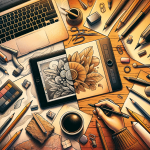Introduction to a Digital Renaissance
Amidst the digital revolution, art and technology have become closely connected, signaling the arrival of a new era of imaginative discovery. This convergence has disrupted conventional artistic boundaries, catapulting us into a domain where creativity merges with digital expertise. At this critical point, we are on the verge of a new era in design, when the combination of artistic intuition and technological innovation offers a future full of undiscovered opportunities.
Exploring the World of Virtual Reality
One of the remarkable creations resulting from this combination is the domain of virtual reality (VR) art. Virtual Reality (VR) functions as a gateway to realms unrestricted by physical limitations, where artists create an all-encompassing cosmos that fully engages the senses. Through this process of digital alchemy, we can navigate the canvas and immerse ourselves in the artwork, interacting with extraordinary landscapes and otherworldly creatures. VR surpasses simple observation, beckoning us to engage in a mutually beneficial interaction with the artwork, where all our senses are aroused and our perceptions are questioned.
The Digital Vanguard
The advent of the digital era has led to a group of innovative individuals who combine technology and artistic techniques to create exceptional works of art. These skilled craftsmen utilize technology as their medium, creating pictures that challenge traditional norms and surpass expectations. Their scope is extensive, covering the intangible realms of digital illustration, the fluid movement of motion graphics, and the tangible marvel of interactive art. These individuals are not only artists but also creators of digital experiences, exploring new frontiers in the continuously growing realm of creative expression.
Artificial Intelligence and its Influence on Artistic Creativity
Artificial Intelligence (AI) is a central topic of discussion in modern times, occupying a position that blurs the distinction between being a tool and being a creator. The artistic community is both fascinated and apprehensive about AI’s capacity to create art using algorithms. While certain individuals perceive AI as a means for unrestricted creation, others express concern over the potential eradication of the human essence in artistic endeavors. This contrast prompts a deep examination of the fundamental nature of creativity, urging us to imagine a future in which AI acts as a partner in the artistic journey, broadening the possibilities of what might be imagined.
Visualizing the Future: Transitioning from 3D Structures to Interactive Paradises
The future is filled with groundbreaking advancements that are ready to revolutionize our creative engagement. 3D printing serves as a connection between the digital and physical realms, allowing artists to bring their digital ideas to life by creating sculptures, wearable items, and structures that go beyond the confines of a screen.
At the same time, the world of interactive installations invites us to enter dynamic artistic environments. These interactive settings react to our existence, incorporating us into the fabric of the artwork, eliminating the distinction between the artist and the viewer, and promoting a shared canvas of shared experiences.
Epilogue: Mapping the Invisible
As we explore the intersection of art and technology, we enter a realm where our creativity is the only constraint. The amalgamation of these domains holds the potential for not just a progression in the way we generate and value art but also a transformation in our understanding of our environment and our own identities. As we progress, the interdependent connection between artistic imagination and technological innovation continues to develop, ensuring a future where the marvels of the present provide the basis for tomorrow’s great works of art.








